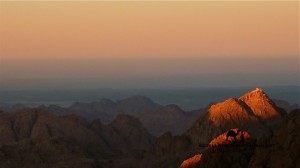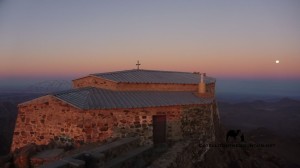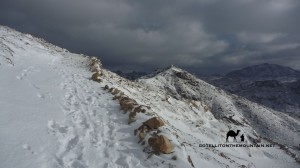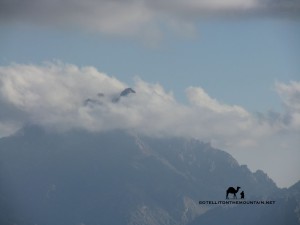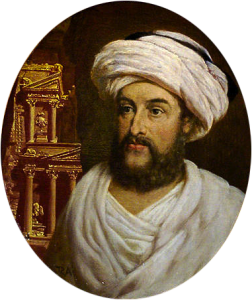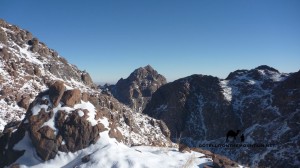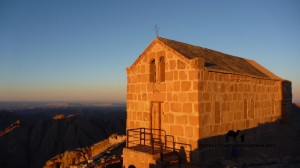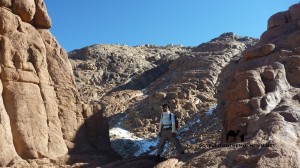March 29, 2015
Three Peaks Egypt: the intel…
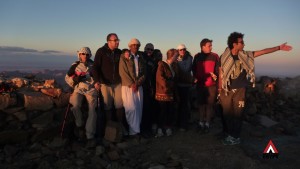 Over the last few months, I’ve been part of a team developing the Three Peaks Egypt Challenge, a new 38km hiking trail in the mountains of the Sinai. It’s Egypt’s first mountain challenge and the only Three Peaks Challenge in the Middle East. Well, it is so far, anyway. Hopefully we’ll see other ones. The whole trail is a community initiative. Its aim is to showcase the beauty of Egypt’s mountains and to revive some of the tourism that’s crashed so disastrously here since Egypt’s revolution. We want it to bring a trickle of hikers through the mountains, to help the local communities. Anyway, so far we’ve produced maps. There’s a GPS track. And route guides. We’ve got a website up and running. All that stuff is free and you can get it HERE.
Over the last few months, I’ve been part of a team developing the Three Peaks Egypt Challenge, a new 38km hiking trail in the mountains of the Sinai. It’s Egypt’s first mountain challenge and the only Three Peaks Challenge in the Middle East. Well, it is so far, anyway. Hopefully we’ll see other ones. The whole trail is a community initiative. Its aim is to showcase the beauty of Egypt’s mountains and to revive some of the tourism that’s crashed so disastrously here since Egypt’s revolution. We want it to bring a trickle of hikers through the mountains, to help the local communities. Anyway, so far we’ve produced maps. There’s a GPS track. And route guides. We’ve got a website up and running. All that stuff is free and you can get it HERE.
Since then, the emphasis has been on walking and re-walking the challenge in a general intelligence gathering exercise; figuring out its secrets to advise hikers with the best tips and to find the best ways of supporting challenges with guides, camels, accommodation for the local community etc.
Growing a trail is like growing a tree. It’s a long process and we’ll be working on this for years to come. Anyway, I’ve been able to reflect a bit on the first phase a bit lately. So here’s what I know about the 12 and 24 hour options.
THREE PEAKS EGYPT: 24 HOUR CHALLENGE
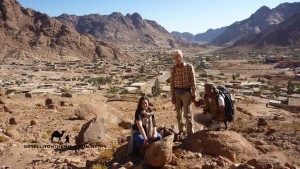 I reckon this will become the classic way to do the challenge. It’s manageable if you have a good level of fitness and stamina and walk it the right way. The first guy to do it was a 57 year old engineer called Leo who walks barefoot in the Alps and who’d taken a month-long walkabout in the Sinai prior to the challenge. He got round in an impressive 16 hours and 6 minutes. Also with us was Olivia, a PhD grad studying bee pollination in the Sinai who took a generally dim view of the whole Three Peaks Egypt Challenge, telling us she’d done all three peaks before and saw no good reason doing them again, especially not on the same day, and that she was coming for a nice walk and would retire half way around. Which is exactly what she did, despite our best protestations.
I reckon this will become the classic way to do the challenge. It’s manageable if you have a good level of fitness and stamina and walk it the right way. The first guy to do it was a 57 year old engineer called Leo who walks barefoot in the Alps and who’d taken a month-long walkabout in the Sinai prior to the challenge. He got round in an impressive 16 hours and 6 minutes. Also with us was Olivia, a PhD grad studying bee pollination in the Sinai who took a generally dim view of the whole Three Peaks Egypt Challenge, telling us she’d done all three peaks before and saw no good reason doing them again, especially not on the same day, and that she was coming for a nice walk and would retire half way around. Which is exactly what she did, despite our best protestations.
OK, so here are my main impressions and top tips for the trail:
1. Slow and steady. Go slow and steady. Look on yourself as playing the part of the tortoise in that old fable about the tortoise and the hare. The hare tears off to the horizon, then relaxes and sleeps, letting the tortoise overtake to finish first. You have to be the tortoise. You don’t need to go super fast. You can go slow. But you have to keep going. You have more time on this challenge than you might think. We set a manageable pace all the way along and took breaks for tea, lunch, pictures etc. Go too fast and you’ll burn out too early.
2. Night hiking. This is unique to the 24 hour challenge. Don’t underestimate it. The paths are loose and uneven and you have to stay 100% focused to avoid a tumble. The darkness also makes it harder to judge how far you’ve gone, how far you’ve got to go etc. Everything feels further. It’s a psychological thing. Take a headlamp and spare batteries. Or hike in spring, when the day is longer. Try to get to Farsh Umm Silla on Jebel Katherina before dark too: just before it is a scrambling section that would take much longer at night.
3. To sleep or not to sleep? I was sorely tempted. There was the hiking hut on Jebel Katherina. A Bedouin tent at the bottom. Cushions. A fire. A hot meal. Actually, we’d planned to sleep here. But then Leo piped up wanting to head up Mount Sinai. Maybe a short power nap on the spot would help. Anything more though, probably not. Setting off after an hour was tough enough. Waking up, pulling on a backpack and pressing the muscles back into service up another mountain would have been a tall order indeed.
4. Small, light meals. We had really good meals. They gave us energy and were a chance to relax and make plans on how to finish. They say the best plans are laid with a full belly. I’d add the caveat that executing those plans with a full belly – especially on a 38km mountain challenge – is another matter entirely. I ate seconds and thirds on this challenge. And I paid the price. I felt like an anaconda that had swallowed a calf afterwards, hauling myself up the mountain. My top tip: eat smaller meals and energy snacks like dates, halawa, chocolate…
5. Know how it works. Ask your guide how the logistics of the trail will work before you do it. This will help you plan each stage. If you’re in a group, a camel will usually meet you half way. That means you can think of it as a game of two halves; carrying lighter loads on each. Know the water points too. There’s more water on the first half than the second, so you can go lighter on the first, drinking water on the way. This will preserve your energy; travelling lighter will also be better for your feet and knees. You’ll feel better.
THE 12 HOUR CHALLENGE: EXTREME
 A Bedouin man-of-steel called Salem – born at the foot of Jebel Katherina – was supposed to be doing this. Until he got laid low by a stomach bug. Then I was the next in line. Generally, these extreme sort of challenges aren’t my thing. And generally, since school, I’ve had the knack of being in the wrong place at the wrong time when the dubious chance of doing one comes around. Cross country races. The 1500m. Half bloody marathons. I’ve been roped into all of them. History repeats itself. I hardly slept before this: I never do when I’ve got to get up early. Especially not with a 38km mountain challenge looming over me like the Sword of Damocles. Anyway, this was tough: but definitely not impossible. I took 9 hours 28 minutes and 30 seconds. Watch a video HERE.
A Bedouin man-of-steel called Salem – born at the foot of Jebel Katherina – was supposed to be doing this. Until he got laid low by a stomach bug. Then I was the next in line. Generally, these extreme sort of challenges aren’t my thing. And generally, since school, I’ve had the knack of being in the wrong place at the wrong time when the dubious chance of doing one comes around. Cross country races. The 1500m. Half bloody marathons. I’ve been roped into all of them. History repeats itself. I hardly slept before this: I never do when I’ve got to get up early. Especially not with a 38km mountain challenge looming over me like the Sword of Damocles. Anyway, this was tough: but definitely not impossible. I took 9 hours 28 minutes and 30 seconds. Watch a video HERE.
OK, so here are the main things I’d say if you’re doing it.
1. A fast walk – not a run. You can do this as a fast walk. I ran less than 300m. My plan was to start it as a walk. If I was doing OK, I’d carry on; if I was lagging, I’d run. I got to the half way point in four hours. After that, I knew I’d be OK. Beware though, time is bearing down. It’s breathing down your neck all the way. So although you can do it as a walk, you have to keep going. I took six rests. Most were 3 minutes. The longest was 7 minutes. It’s like being the tortoise again. This time though, a sort of thoroughbred racing tortoise.
2. Use the daylight. You’ll have at least 12 hours of daylight in the Sinai, even in winter. Which means you should be able to do it all outside darkness, as long as it goes to plan. The 12 hour challenge isn’t one for the dark…
3. Watch the clock. Time ticks mercilessly away on the challenge, indifferent to your suffering. Make all the time you can in advance. I didn’t take many pictures. I didn’t stop to eat. I didn’t rest much. I put my chocolate bars where I could grab them. I opened the corn beef before I left. I put some TANG in an empty bottle, so it’d be ready when I re-filled it. I put new batteries in everything. Think of what will take time, then cut it out, minimise it, or do it at home. A lot of this challenge is about strategy and having a tight game plan.
4. Choose company wisely. If I’d been with somebody faster I’d have felt I was holding them back. And I hate that. It would’ve been a psychological burden for me. If I’d been with someone slower on a challenge like this, I’d probably have felt held back myself. Alone, it was 100% my pace and my plan. Company can be good, but it depends. If you go with a partner, make sure you’re well matched: that you can tolerate and laugh about each other’s shortcomings.
5. Know the challenge. Knowing every twist and turn meant I didn’t waste time. I knew where I was going. I knew where to get water. I knew those sections where I could go quicker. The downhill stretches. The better paths etc. My top tip is to walk the whole trail before your challenge, figuring everything out.
6. Eating and drinking. No big, heavy meals this time around. I ate on the move. The chocolate bar count was 12. I ate two slices of corn beef. I drank four litres of water. The annoying thing was drinking through a tube. I borrowed a bladder bottle with a drinking tube that dangled round my chest, thinking it was a good idea. Actually, sucking water through a tube messed with my breathing rhythmn. To use an Americanism, it sucked. Literally. So I abandoned it, carrying a small 750ml litre bottle in one hand and reverting to the traditional method of pouring it down my oesophagus when I was thirsty.
7. The pain barrier. Four months ago, some eegit dug a hole outside my front door in St Katherine. I fell into it and didn’t walk properly for a month. Half way through this challenge I couldn’t put my foot down. I thought it was the old injury: actually, I’d strapped it too tight. That was the first pain barrier. Later, the accumulative battering took its toll. Knowing my pace count I reckon I took at least 53,200 steps on the hard, rocky paths. My feet really felt it. The balls and heels. At the end, my body did too. In fact, it felt like my 32 year old self had been reincarnated in my 80 year old self’s body. So be prepared for it to hurt a little…
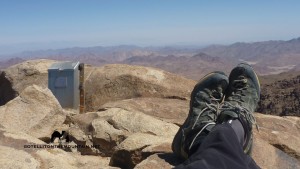 Over the coming weeks we’ll be working all the information into the website, so if you’re serious about doing it, have a look. I haven’t talked about the 72 hour challenge here but that’s also an option. Good for the blazing heat of summer. Or for other inclement weather. And if a challenge event isn’t your thing you can do the walk as a normal hike, in whatever time is comfortable. In the coming months, the next phase here will be setting up a system through which a hiker can do the challenge easily and independently. And it’ll be about finding businesses – ethical, responsible sorts of businesses – that can offer the challenge to people, bringing more people to the local economy and helping the region. Contact me if you need any info on the whole thing!
Over the coming weeks we’ll be working all the information into the website, so if you’re serious about doing it, have a look. I haven’t talked about the 72 hour challenge here but that’s also an option. Good for the blazing heat of summer. Or for other inclement weather. And if a challenge event isn’t your thing you can do the walk as a normal hike, in whatever time is comfortable. In the coming months, the next phase here will be setting up a system through which a hiker can do the challenge easily and independently. And it’ll be about finding businesses – ethical, responsible sorts of businesses – that can offer the challenge to people, bringing more people to the local economy and helping the region. Contact me if you need any info on the whole thing!
